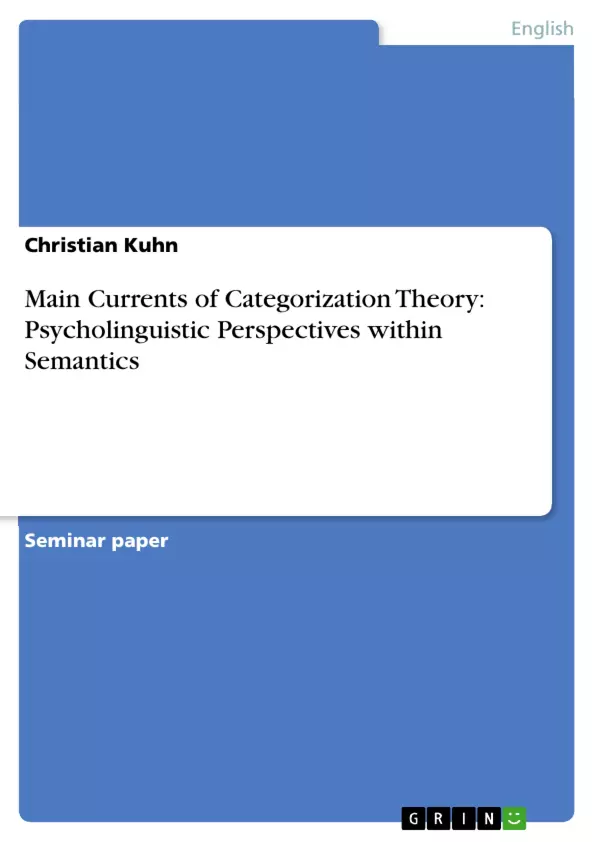From the beginning of arts subject in the ancient Greece to modern cognitive science, scholars have been seeking to discover the nature of the relationship between language and thought. This relationship and the basic processes that underlie reason phenomena in general are today called cognitions. Modern cognitive science consists of an interdisciplinary ensemble of various subjects. Findings from the research for artificial intelligence, results of cognitive psychology, neurophysiology, philosophy, and finally linguistics contribute to a better understanding of any type of mental information processing. As language is said to be among the most characteristic human cognitive activities (see LAKOFF, 1987, p 113; see also BIRBAUMER, 1999, p 675), one aim of this work is to show in what respect linguistic findings are crucial to the aims of cognitive science.
For this purpose I will discuss theories around the concept of categorization which is relevant for the traditional linguistic field of semantics, and also applicable to cognitive psychology and furthermore to psycholinguistics. The categorization approach seems to allow explanation for the communicative functions of language and how humans organize knowledge in general. It seems that: “Categorization is everywhere. Life is full of decisions and every choice involves a selection between a variety of competing options. These choices are guided by the category structure (…), both in language as elsewhere in cognition.” (CORRIGAN et al., 1989, p 195) The process of categorization means that we unconsciously group together every sensory input to meaningful categories. That is, we economically organize the mental representations of the outer world.
From the beginning to the late 1970s and again during the 80s cognitive approaches of psychologists and linguists by the name of e.g. ELEANOR ROSCH, HILARY PUTNAM, and not too long ago GEORGE LAKOFF challenged the classical view of how humans organize knowledge while performing language. Whereas their ideas mainly provided a more integrated view of meaning within language at first, these scholars and especially LAKOFF contributed to a more detailed understanding of the fundamental human ability of categorization. Via the outline of the main currents in categorization theory, my argumentation will lead to emphasising psycholinguistic perspectives in semantic theory, as at least LAKOFF‘s approach may represent a theoretical basis for neuropsychological studies.
Inhaltsverzeichnis (Table of Contents)
- Introduction
- Linguistics within cognitive science
- Preface
- The role of language within thought
- Categorization - concrete contact between linguistics and cognitive psychology
- A survey of categorization theories
- The classical view of categorization
- Prototypes and stereotypes
- Towards a more integrated view on categorization: LAKOFF's ICMS
- Psycholinguistic perspectives
- Basic ideas
- What psycholinguists can get from ICMs
- A final remark on linguistic theories in general
- Summary and Outlook
Zielsetzung und Themenschwerpunkte (Objectives and Key Themes)
This work aims to explore the relationship between language and thought, specifically examining the concept of categorization and its relevance to cognitive science, particularly psycholinguistics. It highlights the significance of linguistic findings in understanding mental information processing, emphasizing the communicative functions of language and how humans organize knowledge.
- The relationship between language and thought
- The role of categorization in cognitive science
- The communicative functions of language
- Human knowledge organization
- The relevance of psycholinguistic perspectives in semantic theory
Zusammenfassung der Kapitel (Chapter Summaries)
The introduction explores the historical and contemporary perspectives on the relationship between language and thought, introducing the concept of cognition as a fundamental human ability. It emphasizes the importance of categorization for understanding how humans organize knowledge and the communicative function of language.
Chapter 2 delves into the role of language within cognitive science, focusing on the field of semantics and its contribution to explaining the communicative function of language. It highlights the challenges in establishing connections between linguistics and cognitive psychology and discusses the importance of understanding the dynamics of categorization within language.
Chapter 3 provides an overview of categorization theories, contrasting the classical view with the prototype and stereotype models. It introduces LAKOFF's idealized cognitive models (ICMS) as a more integrated approach to categorization, offering a theoretical framework for understanding the mental representation of the outer world.
Chapter 4 examines psycholinguistic perspectives on categorization, focusing on the potential benefits of LAKOFF's ICMS for neuropsychological studies. It explores how psycholinguistic insights can contribute to a deeper understanding of the cognitive processes involved in language and thought.
Schlüsselwörter (Keywords)
The main keywords and focus topics of this work are: categorization, cognitive science, psycholinguistics, semantics, language, thought, communication, knowledge organization, idealized cognitive models (ICMS), and LAKOFF's theories.
- Quote paper
- Christian Kuhn (Author), 2003, Main Currents of Categorization Theory: Psycholinguistic Perspectives within Semantics, Munich, GRIN Verlag, https://www.grin.com/document/15163



